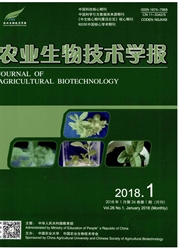

 中文摘要:
中文摘要:
miRNA(microRNA)是重要的转录后调控因子,在很多物种中已获得鉴定,然而对马(Equus caballus)的miRNA相关研究较少。本研究应用Solexa 测序技术对蒙古马的8个组织混合样小RNA进行测序并做了相关的生物信息学分析。结果得到5 199 802个小RNA纯净序列(clean reads),经过长度分布统计和分类注释后,将其与miRBase数据库比对鉴定马的239个保守miRNA。同时,用Mireap软件预测出510个miRNAs,其中238个miRNAs能与马已知miRNA匹配,272个miRNA没能匹配。使用miRanda软件对预测出的所有miRNA进行靶基因预测,获得23 037个靶基因和1 974 153个靶位点。本研究结果丰富了马miRNA数据资源,为进一步研究miRNA在马生物学功能研究工作提供了理论依据。
 英文摘要:
英文摘要:
miRNA (micoRNA) is a very important post transcriptional regulatory factor, and have been identified in many species, whereas miRNA related studies were poor in horse (Equus caballus). In this study, we carried out small RNA sequencing on mixed sample of 8 tissues of Mongolian horse with Solexa sequencing technology and analysed expression abundance of conserved and candidate miRNA, and predicted their target genes with relevant bioinformatic analysis. 5 922 735 clean reads were obtained after trimming low quality reads and adapter sequences from 9 478 925 raw reads which were generated from Illumina Miseq platform. Among them, 5 199 802 reads (15~30 nt) were selected from clean reads for subsequent analysis. After length distribution analysis, we found that total sequences were abundant in 20~24 nt that mainly based on 22 nt, which similar with length distribution of unique sequences. For small RNA annotation, total sequences distributed most in known miRNAs (69%), while unique sequences distributed most in rRNA (49%). Then we compared unique sequences with known miRNAs in miRBase and identified 239 conserved miRNAs and 243 miRNA precursors. In addition, we predicted 510 miRNAs and 375 miRNA precursors with all sequences using Mireap software, in which 238 miRNAs could be matched with horse known miRNAs and 272 non-matched miRNAs might be horse candidate novel miRNAs. The minimal folding free-energy (MFEs) of miRNA precursors reached 18.2~62.8 kcal/mol, which accordant with the requirement of its secondary structural stability. 23 037 target genes and 1 974 153 target sites for all predicted miRNAs were predicted by using miRanda software. These results enrich the horse miRNA database and can provide useful information for further related researches.
 同期刊论文项目
同期刊论文项目
 同项目期刊论文
同项目期刊论文
 期刊信息
期刊信息
